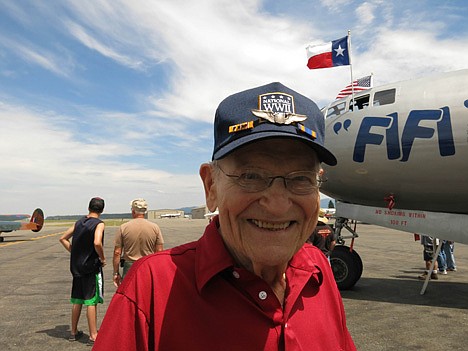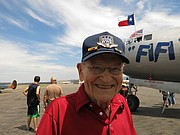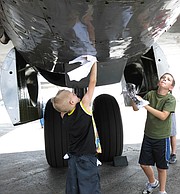Hands-on look at history
Dr. Wilbur H. Lyon says he is not special.
The retired surgeon and former Army Air Force navigator visited the vintage B-29 Superfortress bomber on exhibit at the Coeur d'Alene Airport in Hayden on Wednesday.
During the show, the Commemorative Air Force, a Texas-based flying museum, exhibited "Fifi," a Boeing B-29 Superfortress bomber, and "Bucket of Bolts," a C-45 transport aircraft.
Lyon, a resident of Hayden, visited the airport with his son David Lyon, a retired Navy Commander, who said the two go on daily adventures.
A navigator on B-29 Superfortress bomber in 509th Composite Group which conducted the bombing operations over Hiroshima and Nagasaki, Lyon, now 89, was based on the island of Tinian in the Northern Marianas, where from the B-29 launched its mission to Nagasaki.
"It brings back a lot of memories of when I was actively engaged in the Army Air Force," Lyon said.
He added that it is important for these kind of hands-on exhibits to tour.
"World War II was so different from what young people have to face now," Lyon said. "Everyone felt involved then, and we accomplished our goal. I think today it is more complex for young people to figure out why they are at war."
Lyon, who graduated Harvard Medical School in 1951, said he pursued medicine after his Army Air Force service because it was one of the careers he had always seriously considered as a youth.
"I was a minor part of a major world event," said Lyon, with the modesty commonplace among many of the Greatest Generation. "A lot of people over-talk a lot of stuff."
Lyon's association with the B-29 and its war-ending potential came when he was extracted from a B-24 outfit with which he had completed training, one that was about leave for a 'fight mission' to Germany. He was reassigned to a unit in Wendover, Utah, and began training on the B-29 Superfortress bomber, an aircraft that would be modified for its special mission.
"None of us had ever heard of an atomic bomb," said Lyon, and added that the crew sensed there was something unique about their B-29 training.
"We didn't know we were dropping an atomic bomb until they dropped the first one."
Lyon was part of the group that dropped the bomb on Nagasaki, but not on the mission. After the bomb fell on Nagasaki, he was the navigator on the crew that transported the commander of the 509th, Paul Warfield Tibbets, Jr., and a group of scientists to investigate the impact. The unit stayed in Nagasaki for several weeks, without radiation suits or other protective gear.
"They didn't make the B-29 for my outfit, they modified it," said Lyon. "Ours was specially equipped for the job we needed to do - the scientific equipment was different than any other planes being built. Without it, possibly it wouldn't have been possible to do such a complex mission."





